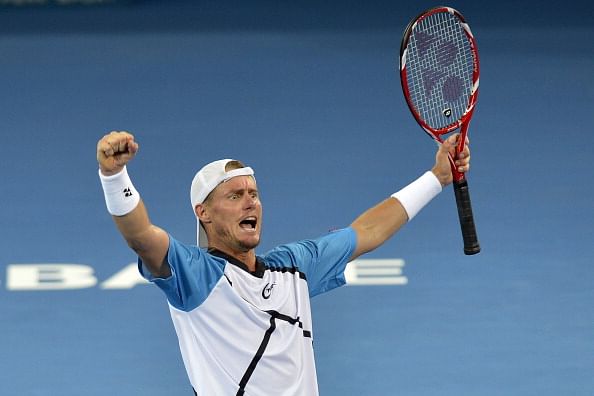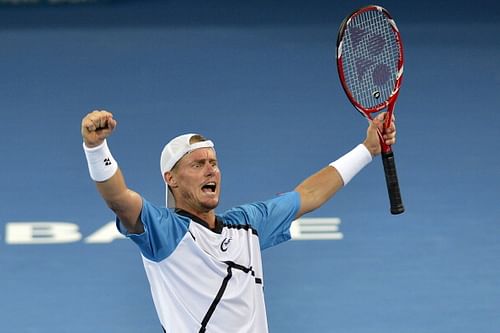
Lleyton Hewitt: The man who doesn't know how to give up

Aggression in every fragment of his body
They say that true aggression is not seen in the words or punches hurled by sportsmen, but in the sense of purpose they exude through their body language. One of Matthew Hayden’s famous quotes about Rahul Dravid goes, “All this going around is not aggression. If you want to see aggression, look into Rahul Dravid’s eyes.” Hayden couldn’t have been more spot-on; Dravid, better known as ‘The Wall’ in cricketing circles, is certainly not someone you’d want to mess with, despite his unmistakably polite demeanour.
In the case of Lleyton Hewitt though, you’d be hard-pressed to find any part of his body or demeanour that doesn’t scream, “I AM GOING TO FIGHT YOU TILL WE ARE BOTH BLOODY AND CRAWLING ON ALL FOURS!!!” Aggression could well have been Hewitt’s middle name; no one does battle quite as fiercely as the veteran Australian tennis star.
It’s in his words; his frequent yells of “Come on!” are enough to get the ground shaking. It’s in his gestures; when he flexes his biceps to form a violent fist-pump, you know he means business. It’s in his eyes, like Dravid; when he gives you one of his death stares, it’s hard to not be intimidated. And it’s in his tremendous, undying, immortal tenacity; no matter how many times you knock him down, he gets back up, ready to keep fighting, to keep the flame of his spirit alive.
Fighting against fate
For Hewitt to come anywhere close to tennis greatness, he almost had to be this unwaveringly intense. The Aussie is not exactly a midget, standing just one inch short of six feet, but he’s blessed with a modest build, and not nearly enough muscles to rival the likes of Rafael Nadal or Tomas Berdych. His serve is a bit of a lightweight shot among men’s elite, his forehand is many miles slower than that of the power hitters, and even his biggest strength – his backhand down the line – pales in comparison to the way the Murrays and Djokovics hit through the shot.
And all of that is before you start talking about his long list of injuries. The Aussie seems to have spent more time in the hospital than on the court in recent years, moving from one potentially-career-ending surgery to another. He’s had recurring problems with his hip, shoulder, foot and hamstring, and he’s scarcely played a full season in the last decade.
Any other player so physically challenged in a sport as competitive as tennis would’ve easily settled for mediocrity. Why spend hours trying to accomplish something that you weren’t meant to accomplish? Why bust your back trying to do things that you weren’t born to do?
Trying till his last breath – and having the numbers to show for it
Fortunately for the sporting world, nobody ever posed those questions to Hewitt. The man likely never learned the meaning of the term ‘give up’. Letting go was never an option for him, nor was lamenting the curel hand dealt to him by fate. So what if he wasn’t built to belt a tennis ball at supersonic speeds? He’d be danged if he didn’t find a way to win without belting the ball at supersonic speeds.
So Hewitt kept diligently picking up his racquet, kept swinging and smoothening his technique, kept sprinting all over the court, kept trying to perfect hitting shots on the run, and kept trying to improvise. He kept trying.
And no one can ever say he didn’t try enough. Hewitt became the youngest ever World No. 1 – aged just 20 – back in 2001, just weeks after defeating Pete Sampras in the US Open final. He went on to add another Slam at Wimbledon the next year, and finished as the year-end No. 1 for two seasons in a row. He was also part of two winning Davis Cup campaigns for Australia – in 1999 and 2003.
The memories
For most players, that list of achievements would be enough to last a lifetime. And yet, these numbers don’t even come close to revealing the full extent of Hewitt’s greatness. His never-say-die attitude is not reflected in vulgar statistics like number of Slams or number of weeks ranked No. 1. No; the real worth of a player like Hewitt is encapsulated in the memories that he has left behind in the hearts of the spectators, the competitive fire that remains burned in the eyes of everyone who watched. Because, by golly, his fighting spirit has made for some truly unforgettable scenes of sporting theatre.
Hewitt has frequently been called the most determined player to ever pick up a racquet, and it’d be hard to argue otherwise.
Who can ever forget his back-to-the-wall victory against Roger Federer in the 2003 Davis Cup tournament? The Swiss led Hewitt by two sets and 5-2 in that encounter, and was just two points from victory in what was then a supremely important competition for Federer. But the Aussie roared back like only he can, clawing his way to a famous five-set win. To this day, Federer maintains that this was the most painful loss of his career – even more than his losses against Djokovic at the US Open, where he twice squandered double match point.
Such miraculous comebacks were the norm for Hewitt in his glory days, when his body could keep up with his mind. But what makes his career even more special is the way he continues to punch above his weight, even as he’s gone well into his 30s. Last year at the US Open, he stunned the Tower of Tandil Juan Martin del Potro in a second round five-set thriller, reminding the world that he wasn’t ready to become a punching bag for the top players just yet.
The ever-glowing source of inspiration
Why does Hewitt inspire me? Because when I look at my life and am tempted to curse God for not making me as intelligent as my peers, I think back to Hewitt and remember that it’s possible to achieve success without being naturally gifted. Because when I am scared that my obstacle is too strong to overcome, I remember Hewitt’s countless victories over bigger opponents and find solace. Because when I feel I just don’t have the energy to go on, I look back on Hewitt’s impossibly long matches that ended well past midnight, and force myself to get the job done.
Getting the job done – that’s a motto that Hewitt seems to have sworn by his entire life. But going about his job was never a drab, mundane affair for the Australian. By channelling aggression through every ounce of his body, Hewitt turned tennis into war. And while those wars may have looked distasteful to some, to the less gifted among us they made for the most reassuring spectacle imaginable.
Now 33 years old, Hewitt keeps chugging along, constantly looking for that last elusive hurrah before he calls time on his career. And as long as he keeps plying his trade on the ATP tour, there will always be an inspiring figure on the court to look up to.
Thank you Lleyton Hewitt, we owe you one.